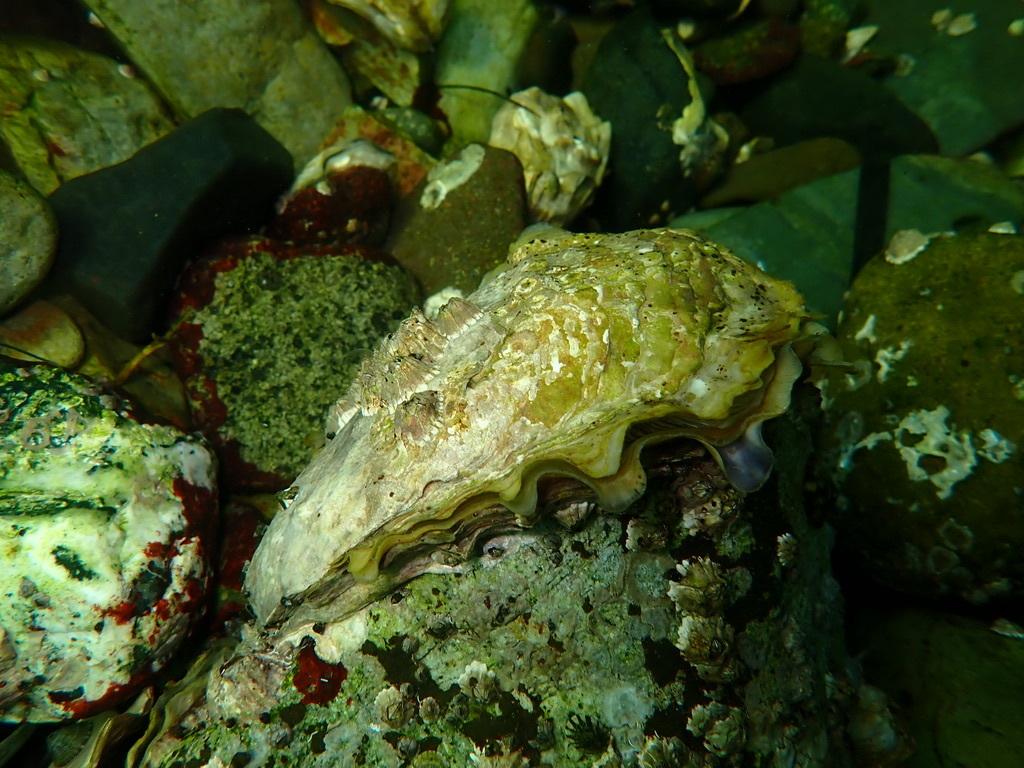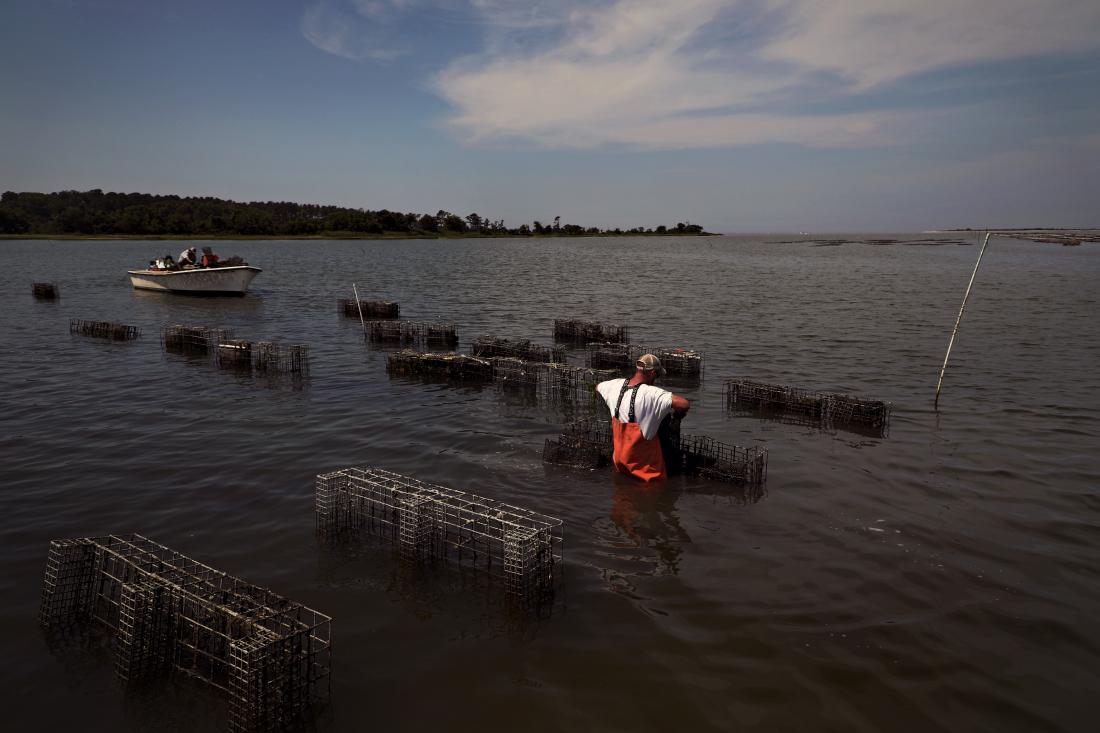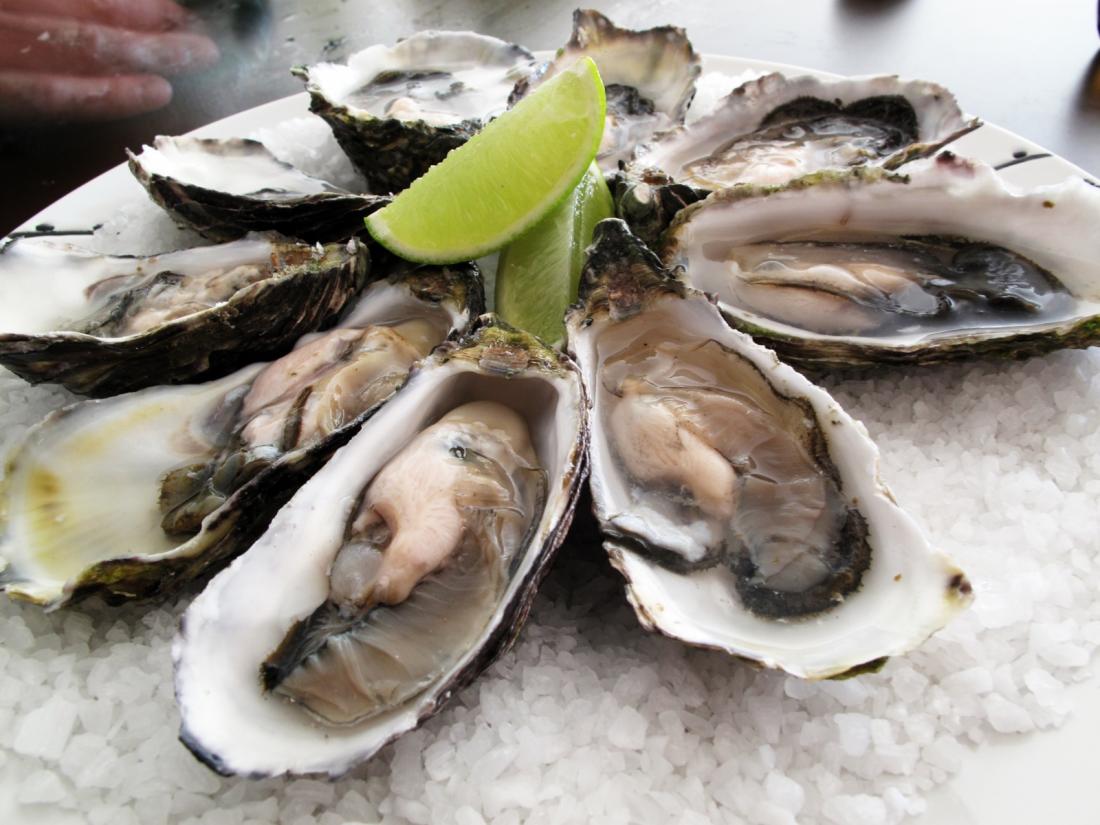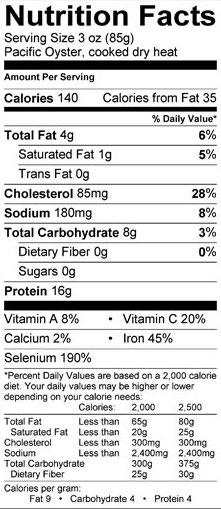Pacific Oyster
Crassostrea gigas
The Science
THE SCIENCE
It is possible for members of the food oyster family like this one to produce pearls but they are in a different family than the pearl oysters.

Taxonomic description
- Has an elongated, sculpted shell with rounded radial folds (wavy). [3]
- Shell is rounded with fluting when grown on hard substrate; oval, smooth on soft substrate.
- Usually white with purple streaks & spots, the inside of shell is white with a purple hue over muscle scar. [1,2]
- Shell length is normally 10-15 cm (4-6’), but as long as 38 cm (15’). [1]
Distribution
- Occurs naturally in estuarine & coastal waters of Japan and Southeast Asia. .[1,2]
- Was introduced around the world as a way to revive exploited oyster stocks. [2]
- In North America, it occurs from southeastern Alaska to Baja California.
Life history
- Can live up to 30 years, but is fully mature and able to reproduce after 1 year. [2]
- Grows 2.5 cm (1”) per year. [3]
- Begins life as a male, but after a year functions as a female. [3]
- Spawning is temperature dependent, usually occurring when warm (i.e., often summer breeders).
- Minimum temperature needed for reproduction is 15° C (59° F), maximum temperature is 34° C (93.2° F). [3]
- Fertilization occurs externally, and free-swimming larvae group together to find suitable habitats on which to settle. [3]
Habitat
- Found in sheltered waters, from slightly above sea level to subtidal depths of 3 meters (9.8 ft). [3]
- Settles on hard surfaces, such as rocks, pier pilings, shells of adult oysters or other shellfish species. [3]
- As a filter feeder, it feeds on phytoplankton & detritus in the water.
- Predators include seastars, crabs, benthic feeding fish, and wading birds. [3]
The Fishery
THE FISHERY
It is a myth that oysters are poisonous during months without the letter “R” in them (summer months); a lot of energy is put into reproduction in these months leaving the meat too thin and watery for marketing.

Seasonal availability
- Available year-round when farm-raised.
Regulatory and managing authority
- Marine aquaculture in California is overseen by a number of federal and state agencies the specifics of which depend upon the location of the facility (land, state waters, federal waters) and type(s) of species grown. These agencies include but are not limited to NOAA, for oversight in federal waters, California State Lands Commission, for oversight in coastal waters and land, and California Department of Fish and Wildlife for registration. [12]
- A State Aquaculture Coordinator provides guidance on permits, registrations, and consultations, which are required for all commercial aquaculture. [12]
- The California Department of Public Health is involved in growing, harvesting, and selling molluscan shellfish and seaweeds. [12]
- On public and private lands, aquaculture must follow regulations regarding water discharge, which involves multiple management agencies. [12]
- The Permit Guide to Aquaculture in California is available at https://permits.aquaculturematters.ca.gov/Permit-Guide#454735-california-department-of-public-health. [12]
Gear type
- Grown in trays submerged in a local embayment. It is removed every 3 weeks, rinsed, and put in a tumbler, which mimics wave action & breaks off the leading edge where shell grows. When put back in trays, the oyster repairs its shell, resulting in a deeper, cupped shape shell & fatter oyster. [5]
- No fertilizers, chemicals or antibiotics are added, and it feeds on naturally occurring phytoplankton.
Status of the fishery
- Most U.S. farms produce their own juvenile oysters (called “seed”) from selected broodstock. [4]
Potential ecosystem impacts
- Aquaculture reduces the pressure on local natural populations and limits the need for imported seafood.
- Shells are recycled for uses in the environment (e.g., nest material for endangered least terns or used in construction by humans). [5]
- This oyster is potentially invasive in local ecosystems due to culinary preference of this Japanese species over the native (i.e., it is prevalent), fast growth and reproductive rates, and tolerance to a wide range of environmental conditions. [5, 6]
- It potentially contributes to the spread of other introduced species (e.g., Atlantic oyster drill).
- This oyster improves water quality through its feeding activity, which removes algae and particulates.
The Seafood
THE SEAFOOD
Oysters are an aphrodisiac... maybe. Oysters contain more zinc than other foods, and zinc is a key mineral for sexual health in men (severe deficiency can lead to impotence). It is more likely, however, that the power of suggestion is stronger than any direct effect.


Edible portions
- Entire contents of the shell.
Description of meat
- Highly valued for its sweet and mild flavor.
- Has a salty kick, and a delicious buttery texture.
Culinary uses
- Local oysters are available fresh; imported can be found canned, or frozen. [8]
- Shucking, or opening, the oyster requires a special shucking knife inserted into the shell to pry it open, and to cut the hinge and adductor muscle in order to remove meat. [9]
- Many people prefer raw oyster, but it can also be roasted, steamed, fried, scalloped, stewed, baked, stuffed, boiled, marinated, poached and sautéed.
- Some meal ideas include oyster stew, pan fried oysters, scalloped oysters with fennel, glazed oysters on crab and leeks, and chicken with oysters and straw mushrooms. [10]
Nutritional information
- Nutritional information for 100g of Pacific oyster can be found on the table to the right. [7]
Toxicity report
- There are currently no reported contaminants from local farm raised oyster [11]; wild caught oyster from San Diego is not recommended for consumption without bay water quality and oyster toxicity analyses.
- Consumption of raw oysters may lead to vibriosis, a bacterial infection. To avoid this, it is recommended to look for oysters from reputable sources and restaurants. [13]
Seasonal availability
- Pacific oyster is available farm fresh in San Diego year-round.
References
[1] Moore, T.O., J.D. Moore. 2008. Culture of oysters. Status of the fisheries report. California Dept. of Fish and Wildlife. Web. https://nrm.dfg.ca.gov/FileHandler.ashx?DocumentID=34440&inline. Accessed 4 Sept 2020.
[2] Nehring, S. 2011. NOBANIS. Invasive Alien Species Fact Sheet: Crassostrea gigas. Online Database of the European Network on Invasive Alien Species Web. https://www.nobanis.org/globalassets/speciesinfo/c/crassostrea-gigas/cr…. Accessed 4 Sept 2020.
[3] NIMPIS 2013, Crassostrea gigas reproduction and habitat, National Introduced Marine Pest Information System. Web. https://nimpis.marinepests.gov.au/species/species/133. Accessed 4 Sept 2020.
[4] FishWatch. 2015. Pacific oyster. NOAA FishWatch U.S. Seafood Facts. Web. https://www.fishwatch.gov/profiles/pacific-oyster-farmed. Accessed 4 Sept 2020.
[5] Carlsbad Aquafarm. Prod. Brian Robles and Cindy Kendrick. Green-Scene, 2013. YouTube. https://www.youtube.com/watch?v=Yzy2y5S-A_o. Accessed 4 Sept 2020.
[6] Johnson, C.S. “A new oyster invades” http://caseagrantnews.org/2013/07/02/a-new-oyster-invades/. Accessed 1 July 2013.
[7] Seafood Health Facts. Pacific Oyster, 2013. https://www.seafoodhealthfacts.org/description-top-commercial-seafood-i…
[8] EDF Seafood Selector. 2013. Monterey Bay Aquarium Foundation. http://seafood.edf.org/oysters.
[9] SeafishTheAuthority, 2013. How to prepare Pacific Oysters. www.youtube.com/watch?v=qchyv_HrSHc.
[10] Pacific Coast Shellfish Growers Association, 2013. https://pcsga.org/recipes-nutrition/
[11] Oyster Recommendations. 2019. Monterey Bay Aquarium Seafood Watch. https://www.seafoodwatch.org/seafood-recommendations/groups/oysters?q=p…
[12] Permit Guide to Aquaculture in California. N.d. Permit Guide to Aquaculture in California. Web. https://permits.aquaculturematters.ca.gov/Permit-Guide#454735-californi…. Accessed 21 August 2020.
[13] Gellman, A. Livestrong. 2020. Oysters Are an Excellent Source of 6 Nutrients — Here's How to Eat Them Safely. Web. https://www.livestrong.com/article/293633-raw-oysters-nutritional-facts/. Accessed 15 January 2021.
[14] R. K. iNaturalist. 2020. Digital image. Web. https://www.inaturalist.org/photos/105461265. Accessed 22 February 2021.
[15] Devlin, A. flickr. 2019. Cherrystone Aqua-Farms. Digital image. Web. https://flickr.com/photos/virginiaseagrant/48642407373. Accessed 22 February 2021.
[16] gautsch. flickr. 2008. Pacific oysters. Digital image. Web. https://flickr.com/photos/of_guido/3103519815. Accessed 22 February 2021.



